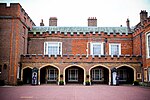Lancaster House
Charles Barry buildingsGeorgian architecture in LondonGrade I listed buildings in the City of WestminsterGrade I listed government buildingsGrade I listed houses in London ... and 6 more
Houses completed in 1840Houses in the City of WestminsterLeveson-Gower familyNational government buildings in LondonNeoclassical architecture in LondonSt James's

Lancaster House (originally known as York House and then Stafford House) is a mansion in the St James's district in the West End of London. It is close to St James's Palace, and much of the site was once part of the palace complex. This Grade I listed building is now managed by the Foreign and Commonwealth Office.
Excerpt from the Wikipedia article Lancaster House (License: CC BY-SA 3.0, Authors, Images).Lancaster House
Stable Yard Road, London Victoria
Geographical coordinates (GPS) Address External links Nearby Places Show on map
Geographical coordinates (GPS)
| Latitude | Longitude |
|---|---|
| N 51.503888888889 ° | E -0.13916666666667 ° |
Address
Lancaster House
Stable Yard Road
SW1A 1BH London, Victoria
England, United Kingdom
Open on Google Maps









